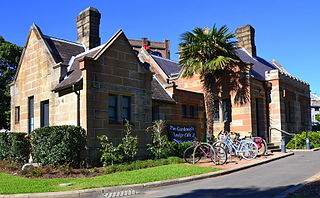
Victoria Park is a 9-hectare (22-acre) urban park situated on the corner of Parramatta Road and City Road, Camperdown, in the City of Sydney, New South Wales, Australia. The park is located adjacent to The University of Sydney and the Broadway Shopping Centre.
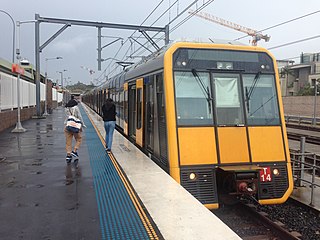
Cronulla railway station is the heritage-listed terminus railway station on the Cronulla line in Cronulla in the Sutherland Shire local government area of New South Wales, Australia. It was designed and built by the NSW Department of Railways during 1939. It is also known as Cronulla Railway Station group. The property was added to the New South Wales State Heritage Register on 2 April 1999.

The Harry and Penelope Seidler House is a heritage-listed modernist house located at 13 Kalang Avenue in the Sydney suburb of Killara in the Ku-ring-gai Council local government area of New South Wales, Australia. It was designed by architects Penelope and Harry Seidler and Harry Seidler & Associates, and built from 1966 to 1967 by Peter Cussel. It was added to the New South Wales State Heritage Register on 20 June 2008.
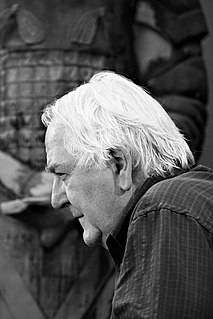
Dr. Graeme Cecil Gunn AM is an Australian architect.
Tzannes is an architectural practice based in Sydney, Australia, active since 1983.

Woolley House is a heritage-listed residence located at 34 Bullecourt Avenue, Mosman, in the Mosman Council local government area of New South Wales, Australia. It was designed by Ken Woolley and built during 1962 by Pettit, Sevitt and Partners. It was added to the New South Wales State Heritage Register on 25 May 2001. The Woolley House is considered a classic example of the Sydney School style of architecture and was the recipient of the Australian Institute of Architects NSW Chapter Wilkinson Award in the year of its construction, the highest award for housing in New South Wales. In 2003 the house was bequeathed to the Historic Houses Trust of New South Wales.

The Walsh Street House, also known as the Boyd House II, is a family home in Walsh Street, South Yarra, Victoria, Melbourne, Australia, designed by Robin Boyd in 1958, which the Boyds moved into a year later. Robin Boyd was known not only as an architect but also an architectural writer, educator and commentator. Born in 1919, as a member of the Boyd family, he came from a creative family background of sculptors, painters and architects. He and his wife Patricia occupied the South Yarra home with their two daughters.

St Peters Lutheran College Chapel is a heritage-listed chapel on the campus of St Peters Lutheran College in Indooroopilly, Brisbane, Australia. It was designed by Karl Langer and built in 1968 by W. W. Groom. It was added to the Queensland Heritage Register on 7 December 2012.

Baronda is a heritage-listed former holiday house at Nelson Lake Road, Nelson Lagoon Mimosa Rocks National Park, Tanja, Bega Valley Shire, New South Wales, Australia. It was designed by Graeme Gunn and built from 1968 to 1969 by Kingsley Koellner (builder) and Hamish Ramsay. It is also known as Yencken House, Baronda Holiday House and Graeme Gunn-designed house. The property is owned by the NSW National Parks and Wildlife Service and the NSW Office of Environment and Heritage. It was added to the New South Wales State Heritage Register on 29 November 2013.
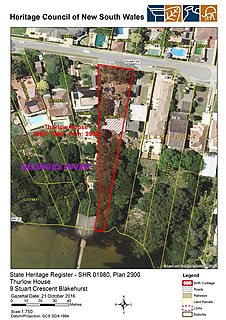
Thurlow House is a heritage-listed residence at 9 Stuart Crescent, Blakehurst in the Georges River Council local government area of New South Wales, Australia. It was designed by Harry Seidler and built from 1953 to 1954. It was added to the New South Wales State Heritage Register on 21 October 2016.

28 Mistral Avenue is a heritage-listed residence located at 28 Mistral Avenue, Mosman in the Mosman Council local government area of New South Wales, Australia. It was designed by E. Jeaffreson Jackson. It is also known as 8 Magic Grove. It was added to the New South Wales State Heritage Register on 2 April 1999.
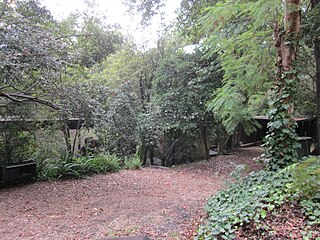
The Jack House is a heritage-listed domestic dwelling at 62 Boundary Road, in the Sydney suburb of Wahroonga in the Ku-ring-gai Council local government area of New South Wales, Australia. It was designed by Russell Jack and Pamela Jack and built from 1956 to 1957 by Donald W. Taylor. It was added to the New South Wales State Heritage Register on 24 June 2013.

Simpson-Lee House I is a heritage-listed residence located at 23 Roland Avenue, in the Sydney suburb of Wahroonga in the Ku-ring-gai Council local government area of New South Wales, Australia. It was designed by Arthur Baldwinson and built from 1958 to 1962 by George M. Koch. It is also known as Simpson Lee House. It was added to the New South Wales State Heritage Register on 27 November 2009.

Cronulla Post Office is a heritage-listed post office at 41 Cronulla Street, Cronulla, Sydney, New South Wales, Australia. It was designed by Edwin Hubert Henderson of the Commonwealth Department of Works and Railways and built in 1924. It was added to the Australian Commonwealth Heritage List on 22 August 2012.
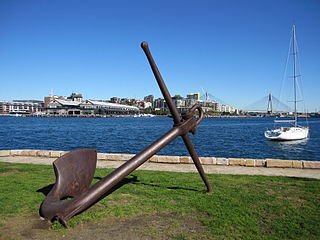
Iloura Reserve is a heritage-listed public reserve on the site of a former timber yard at 10-20 Weston Street, Balmain East, Inner West Council, Sydney New South Wales, Australia. Following the resumption of the timber yard for public space in the 1960s, the present reserve was designed and laid out by landscape architect Bruce Mackenzie and constructed in two stages: stage one in 1970 and stage two in 1981. It is also known as Peacock Point and Illoura. The reserve is owned by the Inner West Council. It was added to the New South Wales State Heritage Register on 29 November 2013.

The Model Factory and Dwelling is a heritage-listed former factory, store and dwelling and now offices located at 120 Gloucester Street in the inner city Sydney suburb of The Rocks in the City of Sydney local government area of New South Wales, Australia. It was designed by George McRae and built from 1912 to 1913. It is also known as Chung Lun Building and (erroneously) the Housing Board Building. The property is owned by Property NSW, an agency of the Government of New South Wales. It was added to the New South Wales State Heritage Register on 10 May 2002.

Science House is a heritage-listed commercial building located at 157–169 Gloucester Street and Essex Street, in the inner city Sydney suburb of The Rocks in the City of Sydney local government area of New South Wales, Australia. It was designed by Peddle Thorp & Walker Architects and built in 1931 by John Grant and Sons, Master Builders. It was also known as Sports House from 1978–1991. The property is owned by Property NSW, an agency of the Government of New South Wales. It was added to the New South Wales State Heritage Register on 10 May 2002.

32-40 Kent Street, Millers Point are heritage-listed terrace houses located at 32-40 Kent Street, in the inner city Sydney suburb of Millers Point in the City of Sydney local government area of New South Wales, Australia. The property was added to the New South Wales State Heritage Register on 2 April 1999.

73 York Street is a heritage-listed former warehouse and now office building located at 73 York Street, in the Sydney central business district in the City of Sydney local government area of New South Wales, Australia. It was built in 1892, with the design having been attributed to Herbert S. Thompson. It is also known as Henley House, Hardware House, ICLE House, Monte Paschi House and Cassa Commerciale House. It was added to the New South Wales State Heritage Register on 2 April 1999.

Qantas House is an Australian heritage-listed office building at 68-96 Hunter Street, Sydney. It was designed by Rudder, Littlemore & Rudder and built from 1955 to 1957 by Concrete Constructions Pty Ltd. It is also known as No. 1 Chifley Square. The site was added to the New South Wales State Heritage Register on 25 May 2001.



















